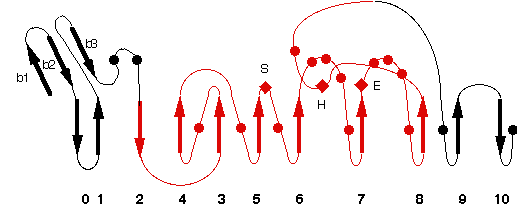4FNG
Name : The alpha-esterase-7 carboxylesterase, E3, from the blowfly Lucilia cuprina 2
Revelation date : 19-Jun-2013
Family : Carb_B_Arthropoda
Gene_locus : luccu-E3aest7
PDB file : ESTHER: header of PDB entry RCSB: Full entry
Comment
Mutations : M364L, I419F, A472T, I505T, K530E, D554G. Authors :Jackson, C.J. , Liu,J-W. , Carr, P.D. , Younis, F. , Pandey, G. , Coppin, C. , Meirelles, T. , Ollis, D.L., Tawfik, D.S. , Weik, M., Oakeshott, J.G.
Ligand :
References (1)
| Title : Structure and function of an insect alpha-carboxylesterase (alphaEsterase7) associated with insecticide resistance - Jackson_2013_Proc.Natl.Acad.Sci.U.S.A_110_10177 |
| Author(s) : Jackson CJ , Liu JW , Carr PD , Younus F , Coppin C , Meirelles T , Lethier M , Pandey G , Ollis DL , Russell RJ , Weik M , Oakeshott JG |
| Ref : Proc Natl Acad Sci U S A , 110 :10177 , 2013 |
| Abstract : Jackson_2013_Proc.Natl.Acad.Sci.U.S.A_110_10177 |
| ESTHER : Jackson_2013_Proc.Natl.Acad.Sci.U.S.A_110_10177 |
| PubMedSearch : Jackson_2013_Proc.Natl.Acad.Sci.U.S.A_110_10177 |
| PubMedID: 23733941 |
| Gene_locus related to this paper: luccu-E3aest7 |
Representative scheme of Prolylcarboxypeptidase structure and an image from PDBsum server

